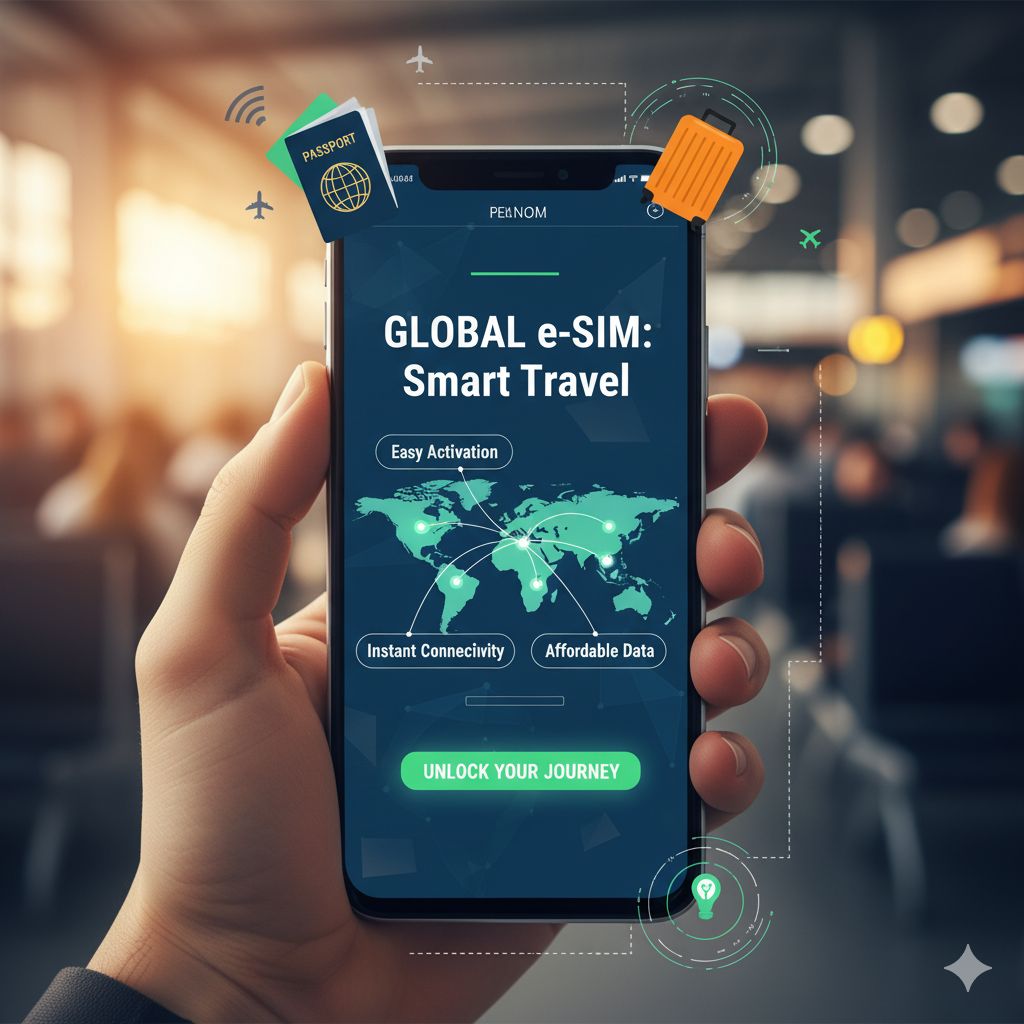
Why Is Global e-SIM Becoming the Top Choice for Frequent Travelers?
Share
Traveling has become an essential part of modern life, whether for business, leisure, or the increasingly popular digital nomad lifestyle. But while flying across countries has become easier, staying connected abroad is still a challenge for many. Traditional roaming plans are expensive, local SIM cards are inconvenient to buy and manage, and switching numbers constantly is frustrating.
This is where the global e-SIM comes into play. Increasingly frequent travelers are switching to this digital solution because it combines flexibility, cost savings, and convenience in one package. Let’s explore why this technology is becoming the top choice for people who are always on the move.
What Is a Global e-SIM?
A global e-SIM, short for “embedded SIM,” is a virtual SIM that’s built directly into your smartphone or tablet. Unlike traditional SIM cards, you don’t need to physically insert or swap it. Instead, you can download e-SIM plans digitally and activate them in minutes.
The key advantage is freedom. With a physical SIM, you’re tied to one provider. With an e-SIM, you can switch between networks whenever you like, making it a perfect fit for frequent travelers. Imagine landing in Tokyo today, hopping over to Sydney tomorrow, and then moving on to New York—all while staying connected with the same digital SIM. That’s the power of a global e-SIM.
Why Frequent Travelers Struggle with Traditional SIM Cards
Most seasoned travelers know the pain points of staying connected abroad. First, there’s the hassle of buying SIM cards in foreign countries. After a long flight, the last thing you want is to queue at an airport kiosk or search for a mobile shop in an unfamiliar city. Sometimes, language barriers and confusing plans make the process even harder.
Then there are the costly roaming charges. Traditional roaming packages often come with steep prices and hidden fees. Even a short business trip can leave you with a surprisingly high bill when you get home.
Finally, switching numbers constantly is inconvenient. Each time you use a new local SIM, you’re forced to change your phone number. This makes it difficult to stay in touch with colleagues, clients, or family, and it feels unprofessional if you’re traveling for business.
These struggles make it clear why frequent flyers are turning to more modern solutions.
Key Benefits of a Global e-SIM for Travelers

The reason the global e-SIM is gaining popularity is simple—it solves problems that travelers have faced for years. Here are the biggest benefits:
Cost savings and transparency – With prepaid e-SIM plans, you know exactly what you’re spending. No hidden fees and no shock bills when you return home.
Seamless connectivity worldwide – You can travel across multiple countries without changing your SIM or losing connection. It’s as if your phone adapts to wherever you are.
Convenience – Forget fiddling with SIM trays or carrying multiple cards. An e-SIM plan can be activated directly on your phone within minutes.
Flexibility – You’re free to switch between providers and find the best coverage in each destination without physically swapping SIMs.
Professional communication – Many devices let you use both your home SIM and an e-SIM at the same time. This means you keep your original number for calls while using your global plan for data.
This combination of affordability, convenience, and practicality explains why the global e-SIM has become such a trusted travel companion.
e-SIM Plans: Tailored for Every Type of Traveler
The beauty of e-SIM plans lies in their flexibility. They’re designed to meet the needs of different types of travelers rather than forcing everyone into one package.
If you’re going on a short vacation or a quick business trip, a short-term plan gives you just enough data to cover your stay. On the other hand, long-term travelers such as digital nomads or frequent business flyers can opt for multi-month packages that ensure consistent connectivity.
For those who rely heavily on apps like WhatsApp, Zoom, or Skype, data-only e-SIM plans are the most cost-effective. They allow you to use internet-based calls and messages without paying for unused voice minutes. But if you still prefer traditional calls, voice and data packages are available too.
This flexibility means travelers can always find a plan that fits their style. Brands like Sim Swift have taken this a step further by designing packages specifically tailored for different traveler profiles, ensuring you get both value and reliability.
How a Global e-SIM Works in Real Life
The process of using a global e-SIM is refreshingly simple. You choose a plan online, receive a QR code, scan it with your phone, and activate the connection instantly.
For example, imagine you’re flying from London to New York. Before boarding your flight, you purchase an e-SIM plan online. The moment you land, your phone automatically connects to a local U.S. carrier without you doing anything extra. You avoid airport queues, complicated setups, and delays in getting online.
This ease of use is one of the main reasons why so many travelers are switching.
The Role of Technology in Making e-SIMs Reliable
Many people wonder if a digital SIM is as reliable as a physical one. In fact, global e-SIMs often offer even better performance. They rely on encrypted connections, which enhance security, and are supported by partnerships with leading global carriers, ensuring wide coverage.
Most modern smartphones are now designed with e-SIM compatibility in mind. As this technology becomes more widespread, reliability continues to improve, making it a trustworthy option for anyone traveling internationally.
Comparing Global e-SIMs with Local SIMs and Roaming
When you compare the three main options, local SIMs, roaming, and global e-SIMs,the advantages are clear. Local SIMs might be cheap, but they’re inconvenient to buy, and they change your phone number. Roaming is easy, but it’s extremely expensive and unpredictable. The global e-SIM offers the best of both worlds: affordability, transparency, and effortless activation.
It’s a smarter choice that saves both time and money while giving you consistent coverage across borders.
Travelers’ Real Experiences with Global e-SIMs
Frequent travelers who’ve made the switch often say the global e-SIM has completely changed the way they travel. Many highlight the relief of not having to rush around to buy SIM cards after landing in a new country. Others appreciate the savings compared to roaming fees, especially on long business trips.
Digital nomads, in particular, describe the global e-SIM as essential—something they rely on just as much as their laptop or passport.
Why Global e-SIMs Are the Future of Travel Connectivity
Looking ahead, it’s clear that global e-SIMs are not just a trend but the future of travel connectivity. With more smartphones supporting them and more carriers adopting the technology, physical SIM cards are slowly becoming outdated.
Industry experts predict that in just a few years, digital SIMs will be the standard way to connect while traveling. This shift means smoother, more reliable, and more affordable connectivity for everyone.
How Brands Like Sim Swift Are Changing the Market
As demand grows, innovative providers are reshaping the market. Brands like Sim Swift are leading the way by offering simple, affordable, and reliable e-SIM plans. Their focus on user experience ensures that even first-time users find the process quick and hassle-free.
For frequent travelers, this means more time enjoying the journey and less time worrying about connectivity.
Tips for Choosing the Right e-SIM Plan
Choosing the right e-SIM plan depends on your travel habits. First, consider how long you’ll be abroad—short trips require short-term packages, while longer stays benefit from extended plans. Second, think about your usage. Do you need just data for apps and browsing, or will you also be making calls?
Finally, always check whether your device supports e-SIMs before buying a plan. Spending a few minutes comparing options can save you money and frustration later.
Potential Challenges with e-SIMs
While the advantages are clear, there are a few minor challenges. Not all devices support e-SIM yet, although most modern smartphones do. In very remote regions, network coverage may still vary. And for some travelers, the idea of going completely digital might take a little getting used to.
However, these challenges are small compared to the convenience and savings offered by a global e-SIM.
How to Maximize Your Global e-SIM Experience
To get the best experience, make sure you purchase and download your e-SIM plan before you travel. This ensures that you’re connected the moment you arrive. Keep a backup like offline maps in case of temporary signal issues, and always monitor your data usage to avoid running out unexpectedly.
Following these simple steps ensures that your global e-SIM works smoothly wherever you go.
Conclusion
Staying connected while traveling is no longer a luxury—it’s a necessity. The global e-SIM has become the top choice for frequent travelers because it delivers affordability, flexibility, and seamless global coverage. Whether you’re a business professional, a digital nomad, or a casual vacationer, using digital SIM technology means less stress and more freedom.
With brands like Sim Swift driving innovation, the future of travel connectivity is already here—and it’s digital.
FAQs
1. Can I use a global e-SIM with any phone?
Not all phones support e-SIM, but most recent models from Apple, Samsung, and Google do.
2. What happens if I run out of data?
You can easily top up or purchase another e-SIM plan online without changing SIMs.
3. Is it safer than public Wi-Fi?
Yes, using a global e-SIM is far more secure than relying on open public networks.
4. Can I still use my home SIM alongside an e-SIM?
Absolutely—most modern devices allow dual-SIM functionality, meaning you can use both at once.
5. How do I know if my phone supports e-SIMs?
Check your phone’s settings under “Cellular” or “Mobile Data.” If you see an option for “Add e-SIM,” your device is compatible.
